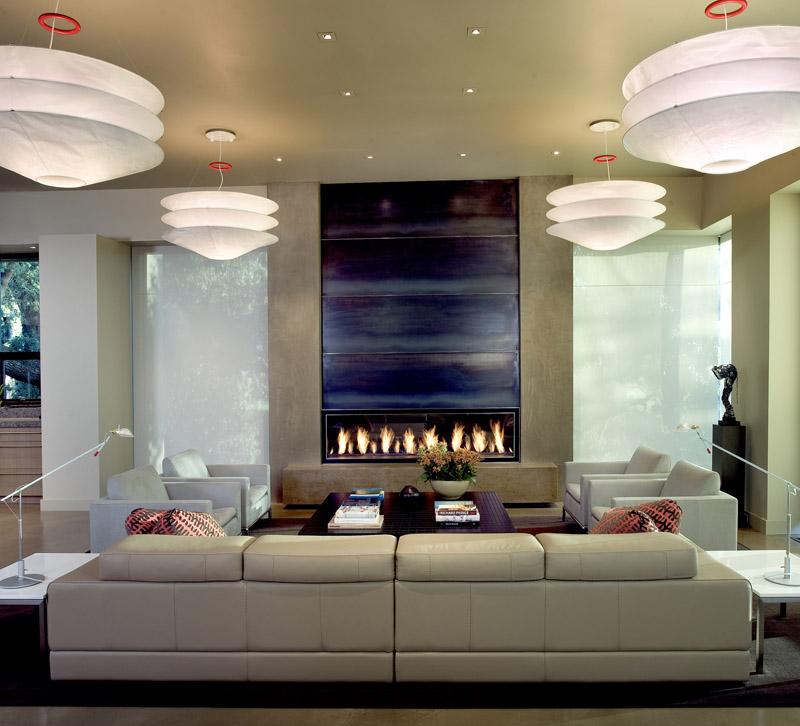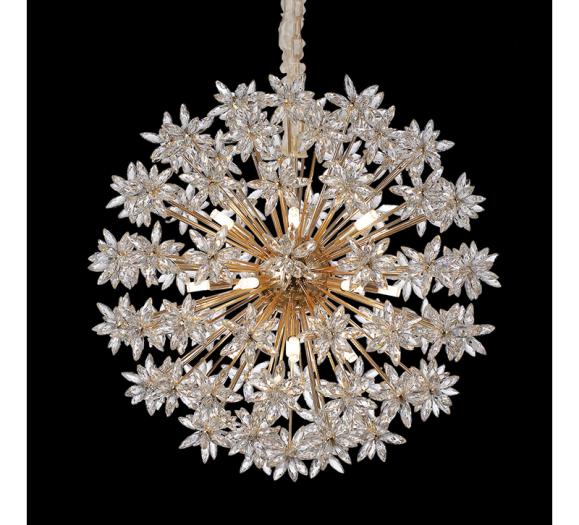TIP 1: Start with basic biology
People are drawn to light like moths are drawn to flame. So, the first rule of thumb is to make the living room the brightest space in the house. Many times, everyone ends up in the kitchen, even if there’s no place to sit and the food and drinks are elsewhere because the lively lighting pulls them in. Use this knowledge to wrangle people into the living room — dim the lights in the kitchen and the dining room. It’ll work like a charm.
Now, bright light does not have to mean glaring light. You want to have a mixed series of sources to throw light in different ways around the room. A chandelier or a pendant fixture or two will act as the beacons to lure your guests in. They don’t have to emit a lot of illumination, they act more as the visual sparkle. They also help create a more human scale to a space that has high or sloped ceilings. They make a big room feel cozier.
Table lamps and floor lamps will create little islands of illumination around seating areas. Think of them as the modern-day equivalent of campfires. People love to gather around a campfire. Also, add some directed light, coming from recessed fixtures or track lighting to highlight art, tabletops, plants and sculpture. This accent illumination creates visual interest and adds one more layer of intriguing luminance to the living room.
TIP 2: Make them feel pretty
Above all, add some ambient light. This is indirect lighting that’s bounced off the ceiling. What this does is create a soft overall warmth to the space and complementary illumination for people’s faces. They will look younger and those people that they’ve been living with forever will suddenly look the best they have in years. This is even before the cocktails start to flow.
Ambient light can be created with different methods. One way is to install cove lighting or cantilever detail around the room with LED lighting tucked inside. You can also install linear LED lighting on top of tall pieces of furniture like armoires or bookcases. Another method would be to install wall sconces that project light upwards. If you want something that doesn’t involve an electrician or contractor, you can buy a pair of torchière lamps, placing them at either end of the room flanking a sofa or a console.
In the olden days (up until about five years ago) linear fluorescents or strip lights fitted with halogen bulbs were used to create this fill light. Now, linear LEDs fit this role to a tee. They are tiny, easy to install, last a long time and save energy. I recommend using a color temperature between 2700K and 2150K. What I’m seeing more of are the warm-dim versions of LED strip lights that go from 3000K down to 2150K. Remember, without warm-dim technology, LEDs will just get less bright, they won’t get warmer in color as incandescents would. No matter which route you go, make sure the CRI is 90 or higher. This just gooses the color quality even closer to the feel of incandescent.
TIP 3: It’s all about control
Don’t forget the dimmers — they’re well worth the investment. It allows you to set the scene for entertaining or just day-to-day living. You can also adjust the light levels as it begins to get darker outside. If you’re using LED sources, which I hope you are, make sure that you get dimmers that are compatible with the light source you’ve selected. Many manufacturers will list the dimmers that are compatible with their products on their website and spec sheets. Some dimming manufacturers, such as Lutron, will test other company’s products and then list which of their dimmers and dimming systems work best.
The challenge here is that the LED companies are continuing to upgrade their components, so what worked before may not work in the future. There are some very good and reasonably priced wireless dimming systems that people can purchase and install themselves. They can even download an app that allows them to control the lights from their mobile devices. How cool is that?!







